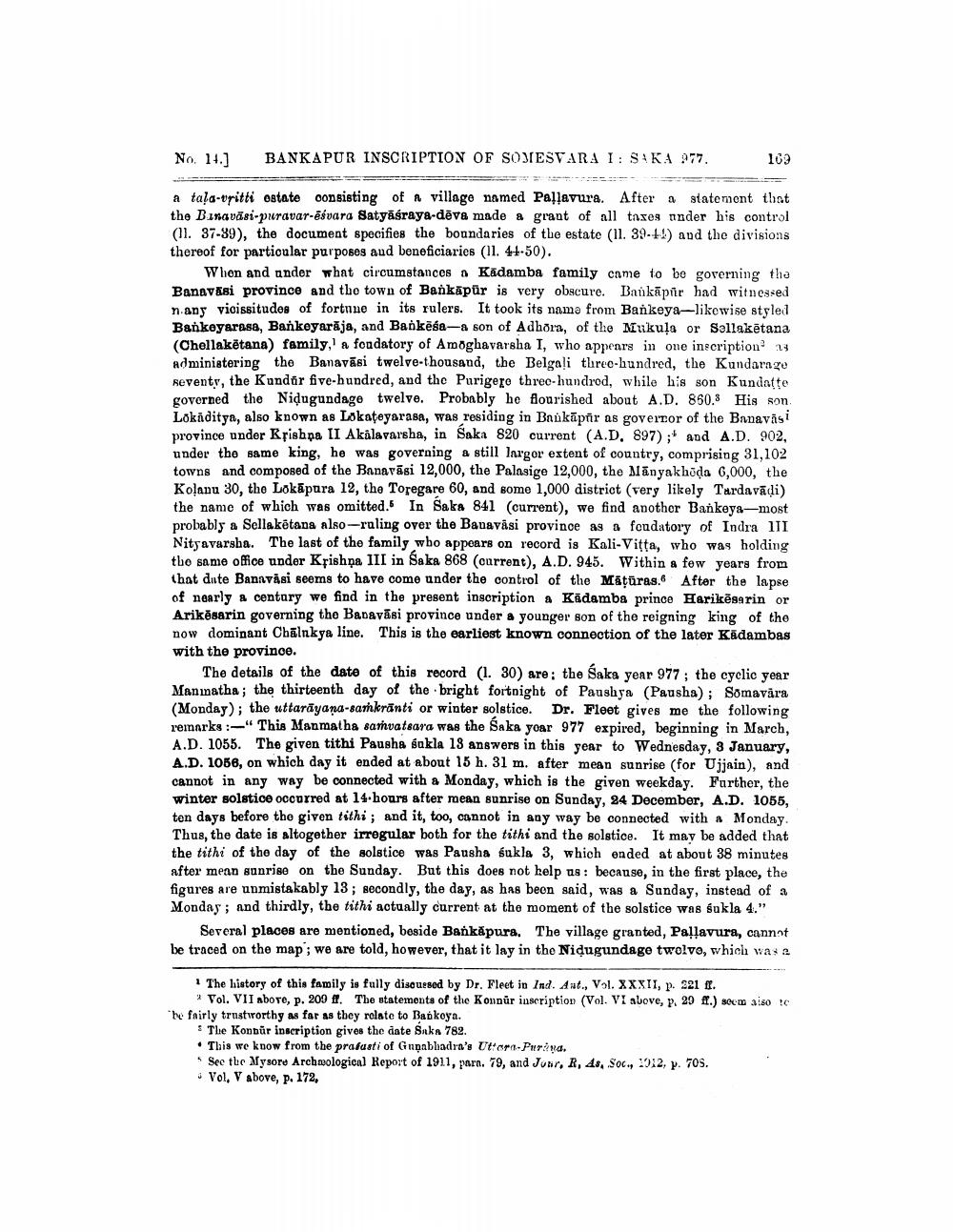________________
No. 14.]
a tala-vritti estate consisting of a village named Pallavura. After a statement that the Binavasi-puravar-ēsvara Satyāśraya-dēva made a grant of all taxes under his control (11. 37-39), the document specifies the boundaries of the estate (11. 39-44) and the divisions thereof for particular purposes and beneficiaries (11. 41-50).
BANKAPUR INSCRIPTION OF SOMESVARA I: SAKA 977.
169
When and under what circumstances a Kadamba family came to be governing the Banavasi province and the town of Bankapur is very obscure. Bankapur had witnessed n any vicissitudes of fortune in its rulers. It took its name from Bankeya-likewise styled Bankeyarasa, Bankeyaraja, and Bankesa-a son of Adhora, of the Mukula or Sellakētana (Chellaketana) family, a feudatory of Amoghavarsha I, who appears in one inscription 13 administering the Banavasi twelve-thousand, the Belgali three-hundred, the Kundarage seventy, the Kundur five-hundred, and the Purigere three-hundred, while his son Kundaṭṭe governed the Nidugundage twelve. Probably he flourished about A.D. 860.3 His son. Lokaditya, also known as Lokateyarasa, was residing in Bankapar as governor of the Banavisi province under Krishna II Akalavarsha, in Saka 820 current (A.D. 897); and A.D. 902, under the same king, he was governing a still larger extent of country, comprising 31,102 towns and composed of the Banavasi 12,000, the Palasige 12,000, the Manyakhoda 6,000, the Kolanu 30, the Lōkāpura 12, the Toregare 60, and some 1,000 district (very likely Tardavaḍi) the name of which was omitted. In Saka 841 (current), we find another Bankeya-most probably a Sellaketana also-ruling over the Banavasi province as a feudatory of Indra III Nityavarsha. The last of the family who appears on record is Kali-Vitța, who was holding the same office under Krishna III in Saka 868 (current), A.D. 945. Within a few years from that date Banavasi seems to have come under the control of the Maturas. After the lapse of nearly a century we find in the present inscription a Kadamba prince Harikesarin or Arikesarin governing the Banavasi province under a younger son of the reigning king of the now dominant Chalukya line. This is the earliest known connection of the later Kadambas with the province.
The details of the date of this record (1. 30) are; the Saka year 977; the cyclic year Manmatha; the thirteenth day of the bright fortnight of Paushya (Pausha); Somavara (Monday); the uttarayana-samkranti or winter solstice. Dr. Fleet gives me the following remarks:-"This Manmatha samvatsara was the Saka year 977 expired, beginning in March, A.D. 1055. The given tithi Pausha sakla 13 answers in this year to Wednesday, 3 January, A.D. 1056, on which day it ended at about 15 h. 31 m. after mean sunrise (for Ujjain), and cannot in any way be connected with a Monday, which is the given weekday. Further, the winter solstice occurred at 14-hours after mean sunrise on Sunday, 24 December, A.D. 1055, ten days before the given tithi; and it, too, cannot in any way be connected with a Monday. Thus, the date is altogether irregular both for the tithi and the solstice. It may be added that the tithi of the day of the solstice was Pausha sukla 3, which ended at about 38 minutes after mean sunrise on the Sunday. But this does not help us: because, in the first place, the figures are unmistakably 13; secondly, the day, as has been said, was a Sunday, instead of a Monday; and thirdly, the tithi actually current at the moment of the solstice was śukla 4."
Several places are mentioned, beside Bankapura. The village granted, Pallavura, cannot be traced on the map'; we are told, however, that it lay in the Niḍugundage twelve, which was a
1 The history of this family is fully discussed by Dr. Fleet in Ind. Aut., Vol. XXXII, p. 221 ff.
2 Vol. VII above, p. 209 ff. The statements of the Konnur inscription (Vol. VI above, p. 29 ff.) seem also te
be fairly trustworthy as far as they relate to Bankeya.
The Konnur inscription gives the date Saka 782.
This we know from the prasasti of Gunabhadra's Uttera-Puriya.
See the Mysore Archmological Report of 1911, para. 79, and Jour, R, 4s, Soc., 1012, p. 70s.
Vol. V above, p. 172,




